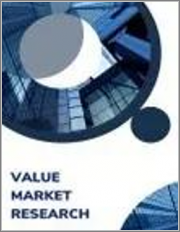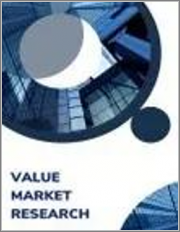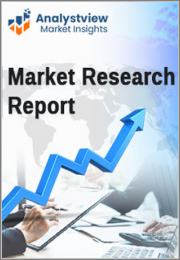
|
시장보고서
상품코드
1305238
세계의 급성 폐손상 치료 시장 조사 보고서 : 산업 분석, 규모, 점유율, 성장, 동향, 예측(2023-2030년)Global Acute Lung Injury Treatment Market Research Report - Industry Analysis, Size, Share, Growth, Trends and Forecast 2023 to 2030 |
||||||
급성 폐손상 치료 시장의 세계 수요는 2022년 62억 2,000만 달러에서 2030년 92억 7,000만 달러에 가까운 시장 규모에 도달할 것으로 추정되며, 2022-2030년 조사 기간 동안 5.12%의 CAGR을 기록할 것으로 예상됩니다.
급성 폐손상 치료(ALI)는 폐에 심각한 염증이 발생하여 폐에 액체가 축적되어 가스 교환이 손상된 상태를 말하며, ALI는 의료 응급 상황으로 즉각적인 치료가 필요한 질환입니다. ALI의 치료는 복잡하며, 병의 중증도와 근본적인 원인에 따라 접근법이 달라집니다. ALI를 면밀히 모니터링하고 관리하는 것은 결과를 개선하고 합병증을 예방하는 데 매우 중요합니다.
시장 역학:
특히 중증 환자의 ALI 유병률 증가는 ALI 치료 시장의 주요 동인이며, ALI 발생률의 증가는 주로 인구 고령화, 만성 질환의 유병률 증가, 입원율 증가에 기인합니다. 기술의 발전으로 ALI의 진단과 치료가 크게 개선되었습니다. 항염증제 및 면역 조절제와 같은 새로운 치료제의 개발은 ALI의 보다 효과적이고 표적화된 치료로 이어지고 있습니다. 각국 정부와 규제 기관은 ALI의 새로운 치료법 개발에 많은 투자를 하고 있습니다. 의료 전문가들은 ALI의 잠재적 위험과 결과에 대한 인식이 높아져 조기 진단과 치료로 이어지고 있습니다. 이러한 인식이 ALI 치료에 대한 수요를 촉진하고 있습니다. 지속적 양압 및 2단계 양압과 같은 비침습적 환기 기술에 대한 수요가 증가하고 있습니다. 이러한 기술은 감염이나 폐손상과 같은 합병증을 유발할 수 있는 침습적인 기계적 환기보다 선호되고 있습니다. 개인 맞춤형 의료에 대한 관심 증가: ALI 치료 시장에서 개인 맞춤형 의료가 인기를 끌고 있습니다. 이 접근법은 유전적 체질, 병력 및 기타 요인을 고려하여 환자 개개인에 맞는 치료법을 적용하는 것입니다. 개인별 맞춤 치료는 ALI의 보다 효과적이고 표적화된 치료로 이어질 것으로 기대됩니다.
조사 보고서는 Porter's Five Forces 모델, 시장 매력도 분석, 밸류체인 분석을 다루고 있습니다. 이러한 도구는 업계의 구조를 명확하게 파악하고 세계 수준에서 경쟁의 매력을 평가하는 데 도움이됩니다. 또한 이러한 도구는 급성 폐손상 치료 세계 시장에서 각 부문을 포괄적으로 평가할 수 있습니다. 급성 폐손상 치료 산업의 성장과 추세는이 연구에 대한 전체적인 접근 방식을 제공합니다.
시장 세분화:
급성 폐손상 치료 시장 보고서의 이 섹션은 국가 및 지역 수준의 부문에 대한 자세한 데이터를 제공하여 전략가가 향후 기회를 통해 각 제품 및 서비스의 대상 계층을 식별하는 데 도움이 됩니다.
치료 방법별
- 기계적 인공호흡
- 약물요법
- 수액 관리
- 기타
최종사용자별
- 병원
- 전문센터
- 기타
지역별 분석
이 섹션에서는 북미, 유럽, 아시아태평양, 라틴아메리카, 중동 및 아프리카의 급성 폐손상 치료 시장의 현재 및 미래 수요를 강조하는 지역 전망을 다룹니다. 또한, 모든 주요 지역의 각 응용 분야에 대한 수요, 추정 및 예측에 초점을 맞추고 있습니다.
목차
제1장 서문
제2장 주요 요약
- 시장 하이라이트
- 세계 시장 현황
제3장 급성 폐손상 치료 - 산업 분석
- 서론 : 시장 역학
- 시장 성장 촉진요인
- 시장 성장 억제요인
- 시장 기회
- 업계 동향
- Porter's Five Forces 분석
- 시장 매력도 분석
제4장 밸류체인 분석
- 밸류체인 분석
- 원재료 분석
- 원재료 리스트
- 원재료 제조업체 리스트
- 주요 원재료 가격 동향
- 잠재적 바이어 리스트
- 마케팅 채널
- 직접 마케팅
- 간접 마케팅
- 마케팅 채널 발전 동향
제5장 COVID-19의 영향 분석
제6장 급성 폐손상 치료 세계 시장 분석 : 치료법별
- 치료법별 개요
- 실적 데이터와 예측 데이터
- 치료법별 분석
- 기계적 인공호흡
- 약물요법
- 주입 관리
- 기타
제7장 급성 폐손상 치료 세계 시장 분석 : 최종사용자별
- 최종사용자별 개요
- 실적 데이터와 예측 데이터
- 최종사용자별 분석
- 병원
- 전문 센터
- 기타
제8장 급성 폐손상 치료 세계 시장 분석 : 지역별
- 지역별 전망
- 서론
- 북미의 매출 분석
- 개요, 실적 및 예측
- 북미 : 부문별
- 북미 : 국가별
- 미국
- 캐나다
- 멕시코
- 유럽의 매출 분석
- 개요, 실적 및 예측
- 유럽 : 부문별
- 유럽 : 국가별
- 영국
- 프랑스
- 독일
- 이탈리아
- 러시아
- 기타 유럽
- 아시아태평양 매출 분석
- 개요, 실적 및 예측
- 아시아태평양 : 부문별
- 아시아태평양 : 국가별
- 중국
- 인도
- 일본
- 한국
- 호주
- 기타 아시아태평양
- 라틴아메리카 매출 분석
- 개요, 실적 및 예측
- 라틴아메리카 : 부문별
- 라틴아메리카 : 국가별
- 브라질
- 아르헨티나
- 페루
- 칠레
- 기타 라틴아메리카
- 중동 및 아프리카 매출 분석
- 개요, 실적 및 예측
- 중동 및 아프리카 : 부문별
- 중동 및 아프리카 : 국가별
- 사우디아라비아
- 아랍에미리트
- 이스라엘
- 남아프리카공화국
- 기타 중동 및 아프리카
제9장 급성 폐손상 치료제 기업 경쟁 상황
- 급성 폐손상 치료 시장 경쟁
- 제휴, 협력, 합의
- 인수합병
- 신제품 출시
- 기타 개발
제10장 기업 개요
- 상위 기업의 시장 점유율 분석
- 시장 집중도
- Mayo Clinic
- Johns Hopkins Hospital
- Cleveland Clinic
- Great Ormond Street Hospital
- Apollo Hospitals
- Tokyo Medical University Hospital
- The Prince Charles Hospital
- Helios Hospital
- Aster Hospitals
- Other
참고 - 기업 개요에서 재무 상세나 최근의 동향은 비공개 기업의 경우 입수 가능 여부에 따라 달라지거나 제공되지 않을 수 있습니다.
ksm 23.08.22The global demand for Acute Lung Injury Treatment Market is presumed to reach the market size of nearly USD 9.27 BN by 2030 from USD 6.22 BN in 2022 with a CAGR of 5.12% under the study period 2022 - 2030.
Acute Lung Injury (ALI) is a condition in which the lungs become severely inflamed, leading to fluid accumulation in the lungs and impaired gas exchange. ALI is a medical emergency that requires immediate treatment. The treatment of ALI is aimed at managing the underlying cause of the condition and providing supportive care to improve lung function and oxygenation. The treatment of ALI is complex, and the approach may vary depending on the severity of the condition and the underlying cause. Close monitoring and management of ALI are crucial to improve outcomes and prevent complications.
Market Dynamics:
The rising prevalence of ALI, especially among critically ill patients, is a major driver of the ALI treatment market. The increasing incidence of ALI is primarily due to the aging population, increased prevalence of chronic diseases, and higher rates of hospitalization. Technological advancements have significantly improved the diagnosis and treatment of ALI. The new therapeutic agents development, such as anti-inflammatory drugs and immunomodulatory agents, has led to more effective and targeted treatments for ALI. Governments and regulatory bodies worldwide are investing heavily in the development of new treatments for ALI. This funding is driving research and development efforts in the field, leading to the development of new and innovative therapies.Healthcare professionals are becoming more aware of the potential risks and consequences of ALI, leading to earlier diagnosis and treatment. This awareness is driving the demand for ALI treatment. The demand for non-invasive ventilation techniques, such as continuous positive and bi-level positive airway pressure is increasing. These techniques are preferred over invasive mechanical ventilation, which can cause complications such as infections and lung injury. Growing focus on personalized medicine: Personalized medicine is gaining popularity in the ALI treatment market. This approach involves tailoring treatments to the individual patient, taking into account their genetic makeup, medical history, and other factors. Personalized medicine is expected to lead to more effective and targeted treatments for ALI.
The research report covers Porter's Five Forces Model, Market Attractiveness Analysis, and Value Chain analysis. These tools help to get a clear picture of the industry's structure and evaluate the competition attractiveness at a global level. Additionally, these tools also give an inclusive assessment of each segment in the global market of acute lung injury treatment. The growth and trends of acute lung injury treatment industry provide a holistic approach to this study.
Market Segmentation:
This section of the acute lung injury treatment market report provides detailed data on the segments at country and regional level, thereby assisting the strategist in identifying the target demographics for the respective product or services with the upcoming opportunities.
By Therapy
- Mechanical Ventilation
- Pharmacotherapy
- Fluid Management
- Others
By End-User
- Hospitals
- Specialty Centers
- Others
Regional Analysis
This section covers the regional outlook, which accentuates current and future demand for the Acute Lung Injury Treatment market across North America, Europe, Asia-Pacific, Latin America, and Middle East & Africa. Further, the report focuses on demand, estimation, and forecast for individual application segments across all the prominent regions.
The research report also covers the comprehensive profiles of the key players in the market and an in-depth view of the competitive landscape worldwide. The major players in the acute lung injury treatment market include Mayo Clinic, Johns Hopkins Hospital, Cleveland Clinic, Great Ormond Street Hospital, Apollo Hospitals, Tokyo Medical University Hospital, The Prince Charles Hospital, Helios Hospital, Aster Hospitals, Other. This section consists of a holistic view of the competitive landscape that includes various strategic developments such as key mergers & acquisitions, future capacities, partnerships, financial overviews, collaborations, new product developments, new product launches, and other developments.
TABLE OF CONTENTS
1 . PREFACE
- 1.1. Report Description
- 1.1.1. Objective
- 1.1.2. Target Audience
- 1.1.3. Unique Selling Proposition (USP) & offerings
- 1.2. Research Scope
- 1.3. Research Methodology
- 1.3.1. Market Research Process
- 1.3.2. Market Research Methodology
2 . EXECUTIVE SUMMARY
- 2.1. Highlights of Market
- 2.2. Global Market Snapshot
3 . ACUTE LUNG INJURY TREATMENT - INDUSTRY ANALYSIS
- 3.1. Introduction - Market Dynamics
- 3.2. Market Drivers
- 3.3. Market Restraints
- 3.4. Opportunities
- 3.5. Industry Trends
- 3.6. Porter's Five Force Analysis
- 3.7. Market Attractiveness Analysis
- 3.7.1 Market Attractiveness Analysis By Therapy
- 3.7.2 Market Attractiveness Analysis By End-User
- 3.7.3 Market Attractiveness Analysis By Region
4 . VALUE CHAIN ANALYSIS
- 4.1. Value Chain Analysis
- 4.2. Raw Material Analysis
- 4.2.1. List of Raw Materials
- 4.2.2. Raw Material Manufactures List
- 4.2.3. Price Trend of Key Raw Materials
- 4.3. List of Potential Buyers
- 4.4. Marketing Channel
- 4.4.1. Direct Marketing
- 4.4.2. Indirect Marketing
- 4.4.3. Marketing Channel Development Trend
5 . IMPACT ANALYSIS OF COVID-19 OUTBREAK
6 . GLOBAL ACUTE LUNG INJURY TREATMENT MARKET ANALYSIS BY THERAPY
- 6.1 Overview by Therapy
- 6.2 Historical and Forecast Data
- 6.3 Analysis by Therapy
- 6.4 Mechanical Ventilation Historic and Forecast Sales by Regions
- 6.5 Pharmacotherapy Historic and Forecast Sales by Regions
- 6.6 Fluid Management Historic and Forecast Sales by Regions
- 6.7 Others Historic and Forecast Sales by Regions
7 . GLOBAL ACUTE LUNG INJURY TREATMENT MARKET ANALYSIS BY END-USER
- 7.1 Overview by End-User
- 7.2 Historical and Forecast Data
- 7.3 Analysis by End-User
- 7.4 Hospitals Historic and Forecast Sales by Regions
- 7.5 Specialty Centers Historic and Forecast Sales by Regions
- 7.6 Others Historic and Forecast Sales by Regions
8 . GLOBAL ACUTE LUNG INJURY TREATMENT MARKET ANALYSIS BY GEOGRAPHY
- 8.1. Regional Outlook
- 8.2. Introduction
- 8.3. North America Sales Analysis
- 8.3.1. Overview, Historic and Forecast Sales Analysis
- 8.3.2. North America By Segment Sales Analysis
- 8.3.3. North America By Country Sales Analysis
- 8.3.4. United State Sales Analysis
- 8.3.5. Canada Sales Analysis
- 8.3.6. Mexico Sales Analysis
- 8.4. Europe Sales Analysis
- 8.4.1. Overview, Historic and Forecast Sales Analysis
- 8.4.2. Europe by Segment Sales Analysis
- 8.4.3. Europe by Country Sales Analysis
- 8.4.4. United Kingdom Sales Analysis
- 8.4.5. France Sales Analysis
- 8.4.6. Germany Sales Analysis
- 8.4.7. Italy Sales Analysis
- 8.4.8. Russia Sales Analysis
- 8.4.9. Rest Of Europe Sales Analysis
- 8.5. Asia Pacific Sales Analysis
- 8.5.1. Overview, Historic and Forecast Sales Analysis
- 8.5.2. Asia Pacific by Segment Sales Analysis
- 8.5.3. Asia Pacific by Country Sales Analysis
- 8.5.4. China Sales Analysis
- 8.5.5. India Sales Analysis
- 8.5.6. Japan Sales Analysis
- 8.5.7. South Korea Sales Analysis
- 8.5.8. Australia Sales Analysis
- 8.5.9. Rest Of Asia Pacific Sales Analysis
- 8.6. Latin America Sales Analysis
- 8.6.1. Overview, Historic and Forecast Sales Analysis
- 8.6.2. Latin America by Segment Sales Analysis
- 8.6.3. Latin America by Country Sales Analysis
- 8.6.4. Brazil Sales Analysis
- 8.6.5. Argentina Sales Analysis
- 8.6.6. Peru Sales Analysis
- 8.6.7. Chile Sales Analysis
- 8.6.8. Rest of Latin America Sales Analysis
- 8.7. Middle East & Africa Sales Analysis
- 8.7.1. Overview, Historic and Forecast Sales Analysis
- 8.7.2. Middle East & Africa by Segment Sales Analysis
- 8.7.3. Middle East & Africa by Country Sales Analysis
- 8.7.4. Saudi Arabia Sales Analysis
- 8.7.5. UAE Sales Analysis
- 8.7.6. Israel Sales Analysis
- 8.7.7. South Africa Sales Analysis
- 8.7.8. Rest Of Middle East And Africa Sales Analysis
9 . COMPETITIVE LANDSCAPE OF THE ACUTE LUNG INJURY TREATMENT COMPANIES
- 9.1. Acute Lung Injury Treatment Market Competition
- 9.2. Partnership/Collaboration/Agreement
- 9.3. Merger And Acquisitions
- 9.4. New Product Launch
- 9.5. Other Developments
10 . COMPANY PROFILES OF ACUTE LUNG INJURY TREATMENT INDUSTRY
- 10.1. Top Companies Market Share Analysis
- 10.2. Market Concentration Rate
- 10.3. Mayo Clinic
- 10.3.1. Company Overview
- 10.3.2. Company Revenue
- 10.3.3. Products
- 10.3.4. Recent Developments
- 10.4. Johns Hopkins Hospital
- 10.4.1. Company Overview
- 10.4.2. Company Revenue
- 10.4.3. Products
- 10.4.4. Recent Developments
- 10.5. Cleveland Clinic
- 10.5.1. Company Overview
- 10.5.2. Company Revenue
- 10.5.3. Products
- 10.5.4. Recent Developments
- 10.6. Great Ormond Street Hospital
- 10.6.1. Company Overview
- 10.6.2. Company Revenue
- 10.6.3. Products
- 10.6.4. Recent Developments
- 10.7. Apollo Hospitals
- 10.7.1. Company Overview
- 10.7.2. Company Revenue
- 10.7.3. Products
- 10.7.4. Recent Developments
- 10.8. Tokyo Medical University Hospital
- 10.8.1. Company Overview
- 10.8.2. Company Revenue
- 10.8.3. Products
- 10.8.4. Recent Developments
- 10.9. The Prince Charles Hospital
- 10.9.1. Company Overview
- 10.9.2. Company Revenue
- 10.9.3. Products
- 10.9.4. Recent Developments
- 10.10. Helios Hospital
- 10.10.1. Company Overview
- 10.10.2. Company Revenue
- 10.10.3. Products
- 10.10.4. Recent Developments
- 10.11. Aster Hospitals
- 10.11.1. Company Overview
- 10.11.2. Company Revenue
- 10.11.3. Products
- 10.11.4. Recent Developments
- 10.12. Other
- 10.12.1. Company Overview
- 10.12.2. Company Revenue
- 10.12.3. Products
- 10.12.4. Recent Developments
Note - in company profiling, financial details and recent development are subject to availability or might not be covered in case of private companies













